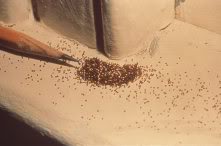Drywood Termites

Drywood termite fecal pellets
Because drywood termites literally live deep in wooden structures, they can cause major damage to your home. These insects are both more destructive and harder to get rid of than other termite species, which live in the soil and enter a house to feed on wood. Drywood termites create small colonies which work slowly: much slower than subterranean termites. So if you suspect that you may have drywood termites, time is on your side. You can schedule a pest control inspection right away before the problem gets out of control. By catching a drywood termite problem early, you will save yourself a lot of time and money.
Where Drywood Termites are Found
Drywood termites are not common throughout the entire US. They are seen most frequently in the following states:
There have also been occasions of drywood termites in other southern states, such as Alabama. These termites are often found enjoying a meal of wood in the attics of homes or in dead trees, but they have also been known to eat wooden furniture. They swarm the most in spring and summer.
Identify a Drywood Termite Infestation
Evidence of drywood termites is usually their “frass,” or droppings. These appear as small, dry, hard, cylindrical fecal pellets on surfaces below the wood they are infesting. Other warning signs that you have a drywood termite problem include:
- shed wings
- pellets of wood they have ejected
- tunneling (gallery) damage inside wood
If you notice frass or any other evidence of drywood termites around your house, then call a pest control expert to conduct a home termite inspection. Once a professional determines the extent of your termite infestation, he will determine the best and most effective way to get rid of the creatures.
How to Get Rid of Drywood Termites:
- If the problem is detected early enough, you may be able to get rid of drywood termites by removing the wood they are living in (such as a section of trim or a piece of furniture) and replacing it with uninfested wood.
- For relatively minor drywood termite problems, consider localized spot treatments or direct wood treatments. Small holes are drilled into the wood and insecticide is then pushed through these holes to be dispersed through the termite galleries (tunnels). This is a very effective method if you are sure that the termites are limited to just a few areas of your home.
- Another type of spot treatment uses liquid nitrogen. The abrupt drop in temperature resulting from its application kills the drywood termites.
- Microwaves may also be used for non-chemical localized treatments. However, this type of pest control is generally less effective and may actually damage the wood that you are trying to preserve.
- Larger infestations can be treated with heat – raising the building temperature to 120 degrees F for 33 minutes or more. Although the home must be evacuated before the treatment, the advantage of this method is that it is non-toxic to humans and pets. However, it may damage components such as electrical outlets.
- Tent fumigation is considered the most effective treatment for whole-house elimination of drywood termites. This entails evacuation of the home for 3-4 days.
- By law, any chemical treatment to get rid of drywood termites must be applied by an experienced, licensed pest control professional.
Updated April 11, 2018.
Looking for a Pro? Call us (866) 441-6648

Pest control Average Costs
Exterminators Experiences

Rental House Termite Treatment – Fast, Thorough, And Well-Priced

Pest Control Got Rid Of Bedbugs From A "Bargain" Headboard



